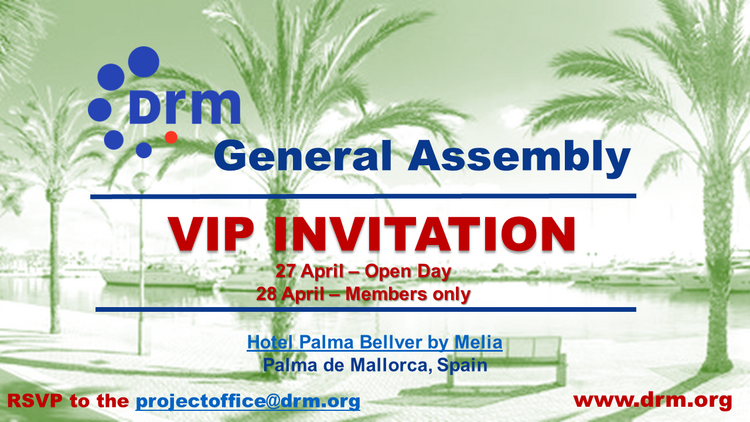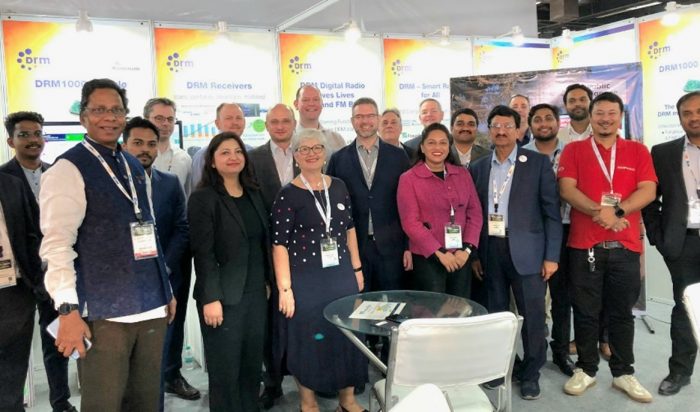Media
DRM 2023 General Assembly
This year’s DRM general assembly will be a hybrid event happening in Miramar, Hotel Palma Bellver, Mallorca, Spain. The 2 day event will take place on 27th April. Day one will be open to invited guests and members. Day 2 is a member only event.
Contact the DRM SA Group on info@drmsa.org if you want to attend the event as a guest.

Radio makes a world of difference to Africa
The theme for the 12th edition of the World Radio Day is Radio and Peace.
[WORLD RADIO DAY] Through the very best of times, when peace has been the liberating breath of an inspired nation, and when, in the very worst of times, the shrill sirens of war have sounded and blocked out good will, radio has been paramount to citizens, communities, and countries.
Read the full article by themediaonline website here.
Proposed Next Generation Radio Spectrum Policy
In September 2022 the Department of Communications and Digital Technologies published the Next Generation Radio Frequency Spectrum Draft Policy for public comment. The objective of this spectrum policy is to use spectrum, a finite and valuable resource, to promote the long-term benefits of socio-economic development. The DRM SA group made comments to this draft policy and in January 2023 we were invited to make oral representation on our written submission. Below is the presentation.
Radio in South Africa turns 100
Read this insightful article published by https://themediaonline.co.za/ about radio’s role in history the past 100 years and its future. https://themediaonline.co.za/2023/02/radio-in-south-africa-turns-100-and-collides-with-podcasting-and-streaming/
World Radio Day – 13 February 2023
DRM Digital Radio, as a Complete Digital Platform for Promoting Information and
Peace, Offers Its Congratulations to UNESCO and United Nations on World Radio
Day
On World Radio Day, the Digital Radio Mondiale (DRM) Consortium wishes UNESCO, the founder of the United Nations Radio in 1946, many decades of successes in promoting the free-to-air radio as a universal way of informing and promoting peace to all citizens of the world with enhanced and relevant content enabled by state-of-the art digital broadcast technologies.
The DRM Consortium (www.drm.org) works closely with global radio associations and broadcasters, founders of this prestigious annual event, towards the progress of digital radio, specifically DRM, a medium that can reach all citizens of a country, even of an entire continent, regardless of where they live.
When information is needed in the furthest corners of the world, DRM is there with news, information and, if needed, disaster warnings (ewf.drm.org).
DRM is also engaged in proving that digital radio can deliver distance schooling and information, being the premises of education and peace all over the world. The DRM is an open, accessible, and flexible standard that has been widely demonstrated globally in all frequency bands. It is a digital platform that saves energy (between 50-90% depending on the bands used) and as such it is increasingly attractive to many broadcasters around the globe (energyeffciency.drm.org).
Large countries, like India, Indonesia, Pakistan, South Africa, Brazil, China, etc. either started rolling out the standard both in the AM and FM bands or are working on their plans to implement it, while cheaper and more affordable receiver solutions are being devised continuously.
All chip manufacturers have included DRM in their products, therefore many more receiver manufacturers, OEMs for cars, are preparing to produce DRM radios. Some of the DRM successes will be showcased in India this week.
https://tinyurl.com/m2es62zz
23 Feb 23 – DRM DIGITAL RADIO – COMPREHENSIVE, ATTRACTIVE AND SUCCESSFUL PRESENCE AT THE BES EVENT IN INDIA
The Digital Radio Mondiale™ (DRM) Consortium and a significant number of its members took part with better exhibits, and presentations than ever before – in the International show of the Broadcast Engineering Society (BES – Exhibition and Conference on ‘Broadcast & Media Technology’ (www.besindia.co.in) held in New Delhi, India on 16-18 February 2023.
The DRM Consortium (www.drm.org) used this opportunity to highlight recent achievements and bring new development under the overarching theme “DRM Saves Lives and Keeps Radio in Business”.
Some of the key DRM Consortium members and partners, including Indian companies like Inntot Technologies, Mobis-Hyundai and OptM, and international ones like Ampegon, CML Microcircuits/Cambridge Consultants, Fraunhofer IIS, Gospell Digital Technologies, NXP, RFmondial and Starwaves, welcomed visitors at their two booths and in the conference hall.

The DRM Consortium proved the great audio and data transmission qualities of the DRM standard in both AM and FM bands by running a low-power transmitter on site. The enhanced service of using one shared transmitter and one antenna to deliver up to 18 audio programmes plus up to 6 dedicated Journaline text services on DRM in FM band was shown with the support of RFmondial and Fraunhofer IIS on mobile devices, standalone and car receivers on show there. This exceptional service for broadcasters wishing to opt for it can ensure additional energy and spectrum savings, while still remaining in full control of their own transmissions and programmes. All during the exhibition the visitors experienced on screen the multi-channel capability of DRM in FM band and some of its key benefit, such as the emergency warnings (DRM EWF – Emergency Warning Functionality). This is an integral part of the DRM standard and could be experienced as audio and Journaline text on the many receivers at the booth and on the colourful DRM Public Signage display thus available to the visually or hearing impaired. DRM can be used also for delivering distance education and schooling without any Internet connection.
For the first time at BES, in the presence of high officials, the DRM representatives supported by NXP demonstrated the AFS (Alternative Frequency Switching) feature of the DRM standard on one of the receivers on display. This was the easy switch between a transmission of a programme from the DRM mode to analogue and then back to DRM by using the mini transmission set up at the booth.
DRM receivers were prominently displayed at BES 2023. Of particular interest was the new CML Microcircuits energy-efficient and very affordable DRM receiver module, a breakthrough solution aimed to give a new impetus to the digital DRM receiver industry in India and elsewhere. Visitors also showed particular interest in the after-market Gospell car receiver and the pocket-size standalone radio, as well as in the Mobis-Hyundai car receiver solution. These are products used already or in demand, as the thriving Indian industry has delivered over 5 million cars with line-fit receivers on the Indian roads until now.
During BES there was a lot of interest in the many and varied Starwaves receivers (including its new desktop receiver W2401). Starwaves is ready to launch its brand-new digital tuner module Warp-3 which can be supplied with or without Wifi/Bluetooth chipset and can make the received DRM content available through its built-in Wifi hotspot.
Inntot Technologies, an award-winning Indian receiver manufacturer, showed at their own booth its high performing and less CPU consuming standalone DRM receiver solution in FM band, as well as its DRM in FM band solution in mobile phones. Inntot’s DRM receiver solution in AM band, already deployed in India, is easily upgradable for DRM reception in the FM band.
The mobile solutions using the DRM standard were much appreciated at the exhibition.
And so were the presentations made at the conference made by Matthew Philipps (CML Microcircuits), Alexander Zink (Fraunhofer IIS) and Dr Thamminana Krushna Rao, honoured with a diploma of excellence by the DRM Consortium for his sustained grassroots work in publicising DRM within the automotive industry.
For the DRM Consortium Chairman, Ruxandra Obreja, BES was the first opportunity to return, after three years, to India “with both excellent DRM transmission updates showcasing the audio and data benefits of the DRM standard and with new solutions for standalone, car and mobile receivers. As expressed throughout the conference and to Indian officials and experts the mass take-up and use of the many DRM features, like emergency warning, distance learning etc. also depends on the decision, still pending, to roll out DRM to the FM band in India. The interest of public and commercial radio decision-makers and the general public in the DRM demonstrations and ground-breaking announcements underlined the great progress made by the DRM Consortium in the last three years. They are all invited to join the effort to help create a digital India for all.”

Note: Article published on the DRM consortium website and re-published here with permission.
December Update
Our end of year newsletter is “a best of the crop“ review with all the new things happening with DRM in 2022. The progress is palpable and would not have been possible without the support of our members. We hope that 2023 will give us the big breakthrough we all wish for. DRM December Newsletter
November Update
ABU General Assembly
The Asia-Pacific Broadcasting Union is the biggest broadcast union in the world. ABU promotes the collective interests of television and radio broadcasters as well as key industry players and facilitate regional and international media co-operation. The ABU general assembly takes place 25-30 November 2022 in New Delhi, India. For more information about the general assembly visit the ABU website. The DRM consortium will be well represented at the meeting with Mr Nigel Fry from the BBC delivering the keynote address and Mr Yogendra Pal – DRM India, Mr Alexander Zink- Fraunhofer IIS and Mr Matthew Phillips – CML Microcircuits presenting on DRM at the technical committee.

October DRM Newsletter

October has been a busy month. Read all about the activities of the DRM consortium from around the world in its October 2022 newsletter. Click here to read: DRM October Newsletter.
Next Generation Radio Frequency Spectrum Draft Policy
In September 2022 the Department of Communications and Digital Technologies published the Next Generation Radio Frequency Spectrum Draft Policy for public comment. The objective of this spectrum policy is to use spectrum, a finite and valuable resource, to promote the long-term benefits of socio-economic development.
The Spectrum Policy derives its enabling principles and guidelines from the 2016 Integrated ICT White Paper policy (“ICT White Paper”), and the 2010 spectrum policy of South Africa. Without deviating from the generality of the ICT White Paper, this policy seeks to utilize the spectrum to drive broader and inclusive economic participation and development for all. The ICT White Paper section about the spectrum supports the “growth and development of the electronic communication services”.
The deadline for public comments was on 20th October. The DRM SA group made a written submission to support the draft policy. Here is out submission and the draft policy for download.
DRM Consortium IBC ‘AM and FM DRM – The ‘Radio Platform for all’ Announces New Receivers and Developments
This year’s overarching theme “DRM for FM and AM – The Radio Platform for All” gave the DRM Consortium the chance to make new receiver announcements and demonstrate the deepening worldwide interest in DRM. A foretaste of all this was given on September 6th as a virtual event, to an audience representing all continents around the world. But for many of the DRM Consortium members, supporters and all those interested in digital radio, the first chance to meet in person, after almost three years of restrictions, was at the “DRM Meet and Greet” event hosted by Fraunhofer IIS at the IBC convention in Amsterdam on September 10th. There the guests enjoyed a chance for renewed networking accompanied by live DRM transmissions received on several receivers and receiver modules displayed at the booth.
CML Microsystems and Cambridge Consultants from the UK for the first time presented the prototype of their upcoming low-cost and all-band DRM receiver module, which will make building affordable DRM radio sets particularly easy. The company representatives announced that the module will be available from Q1 2023.

Gospell presented their entire range of well-established and full-featured DRM receivers consisting of desktop and pocket radios, with support for EWF Emergency Warning Functionality and Journaline text service. In addition, Gospell unveiled their new car radio for easy integration, the Stereo Digital Radio Receiver GR-520. All models provide DRM reception across all DRM broadcast bands.

Next to the Gospell receiver, Starwaves showcased three upcoming DRM receiver solutions: A complete and full-featured DRM and analogue AM/FM receiver module available to receiver manufacturers, with automotive-grade tuning and fast scanning across all DRM frequency bands and support for EWF Emergency Warning Functionality and Journaline text service.
Starwaves also presented its DRM SoftRadio App for Android phones and tablets, which upgrades any existing device to a full-featured DRM receiver simply by connecting an analogue RF SDR dongle. The app is available in major app stores including Google, Huawei and Amazon.

The line-up of new and exciting DRM receiver developments could also be experienced a few hours later at the Nautel stand during the “DRM Is Ready for FM” event.
The audience attending this DRM event learned about the multi-channel use of DRM in FM, as implemented by DRM member RFmondial and demonstrated in India. This was followed by a brief presentation of the recently concluded, successful DRM AM and FM trials in Australia. The focus switched then to Europe and specifically Copenhagen in Denmark, where the DRM in FM trial is continuing on the air.
The DRM Chairman, Ruxandra Obreja, congratulated all those who attended in person the two DRM events during IBC 2022 for their involvement and support of digital radio. Some of them came from as far as India, South Africa, Pakistan, US, Romania, UAE, Australia, China, etc. “It was exciting and even emotional to see again so many people involved in DRM in one single place, to talk to them directly and show them the great progress made by DRM in these last few and very hard years” she said. “It was satisfying to share with all the DRM family less slides but introduce more receivers. There is a real buzz around digital radio and DRM, despite current difficulties and the current economic climate. At IBC we feel that the case for DRM in both FM and AM, as the complete, energy-saving, feature-rich radio platform of the future was comprehensively demonstrated like never before.”
The DRM IBC events were supported by companies including: Fraunhofer IIS, Nautel, Gospell, Ampegon, BBC, Encompass Media, RFmondial, NXP, CML Microcircuits/Cambridge Consultants, Starwaves, OptM, RF2Digital, Skyworks, Radio Republik Indonesia, Pakistan Broadcasting Corporation, Inntot, and many more.
end 12 September 2022
Digital Sound Broadcasting Services Regulations, 2021
After the issuing of the policy direction on the introduction of digital sound broadcasting in South Africa by the Department of Communications and Digital Technologies in 2020, the regulator, ICASA, moved swiftly to start the regulation making process. ICASA issued draft regulations for Digital Sound Broadcasting in November 2020. Public hearings were held in January 2021 and the final regulations were issued in April 2021. Download the final regulations here;









